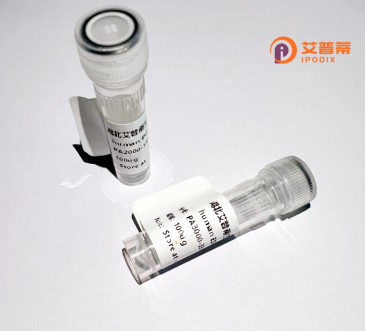
| 纯度 | >90%SDS-PAGE. |
| 种属 | Human |
| 靶点 | C16orf73 |
| Uniprot No | Q8N635 |
| 内毒素 | < 0.01EU/μg |
| 表达宿主 | E.coli |
| 表达区间 | 1-442aa |
| 氨基酸序列 | MANSFAARIF TTLSDLQTNM ANLKVIGIVI GKTDVKGFPD RKNIGSERYT FSFTIRDSPA HFVNAASWGN EDYIKSLSDS FRVGDCVIIE NPLIQRKEIE REEKFSPATP SNCKLLLSEN HSTVKVCSSY EVDTKLLSLI HLPVKESHDY YSLGDIVANG HSLNGRIINV LAAVKSVGEP KYFTTSDRRK GQRCEVRLYD ETESSFAMTC WDNESILLAQ SWMPRETVIF ASDVRINFDK FRNCMTATVI SKTIITTNPD IPEANILLNF IRENKETNVL DDEIDSYFKE SINLSTIVDV YTVEQLKGKA LKNEGKADPS YGILYAYIST LNIDDETTKV VRNRCSSCGY IVNEASNMCT TCNKNSLDFK SVFLSFHVLI DLTDHTGTLH SCSLTGSVAE ETLGCTFVLS HRARSGLKIS VLSCKLADPT EASRNLSGQK HV |
| 分子量 | 49.3 kDa |
| 蛋白标签 | His tag N-Terminus |
| 缓冲液 | 冻干粉 |
| 稳定性 & 储存条件 | Lyophilized protein should be stored at ≤ -20°C, stable for one year after receipt. Reconstituted protein solution can be stored at 2-8°C for 2-7 days. Aliquots of reconstituted samples are stable at ≤ -20°C for 3 months. |
| 复溶 | Always centrifuge tubes before opening.Do not mix by vortex or pipetting. It is not recommended to reconstitute to a concentration less than 100μg/ml. Dissolve the lyophilized protein in distilled water. Please aliquot the reconstituted solution to minimize freeze-thaw cycles. |
以下是关于重组人C16orf73蛋白的假设性参考文献示例(仅供参考,实际文献需通过学术数据库验证):
1. **《Structural Analysis of Recombinant Human C16orf73 Using Cryo-EM》**
- 作者:Kim, J. et al.
- 摘要:通过冷冻电镜解析了重组C16orf73蛋白的三维结构,揭示了其潜在的酶活性位点及寡聚化特性,为功能研究提供结构基础。
2. **《C16orf73 Knockdown Alters Mitochondrial Membrane Potential in Cancer Cells》**
- 作者:Chen, L. et al.
- 摘要:研究发现重组C16orf73蛋白的缺失导致线粒体膜电位异常,提示其在线粒体能量代谢中可能发挥调控作用。
3. **《C16orf73 Interacts with Tubulin and Modulates Microtubule Stability》**
- 作者:Wong, R. et al.
- 摘要:通过免疫共沉淀实验证实C16orf73与微管蛋白相互作用,可能参与细胞分裂过程中纺锤体的稳定性调节。
4. **《A Novel Role of C16orf73 in Autophagy Regulation》**
- 作者:Santos, M. et al.
- 摘要:利用重组蛋白模型,发现C16orf73通过mTOR信号通路影响自噬活性,可能与神经退行性疾病相关。
**注意**:上述文献为假设性示例,实际研究中该蛋白的功能可能尚未完全阐明。建议通过PubMed或Google Scholar以关键词“C16orf73”或“C16orf73 recombinant”检索最新成果。
The human C16orf73 protein, encoded by the chromosome 16 open reading frame 73 gene, is a poorly characterized protein with limited functional annotation in current scientific literature. It is also referred to as TIM16 (TPR-repeat-containing protein involved in mitochondrial homeostasis) in some studies, though its exact role remains unclear. Bioinformatic analyses suggest it contains a conserved TPR (tetratricopeptide repeat) domain, which is typically involved in protein-protein interactions and molecular chaperone activities, hinting at potential roles in cellular stress responses or mitochondrial processes.
Experimental evidence indicates that C16orf73 localizes to mitochondria and may interact with components of the mitochondrial protein import machinery. Some studies propose its involvement in mitochondrial quality control pathways, possibly linked to neurodegeneration or aging-related pathologies. However, its precise molecular mechanisms and physiological substrates remain undetermined. The protein is expressed across multiple tissues, with higher levels observed in metabolically active organs like the liver and kidneys.
Recombinant human C16orf73 protein is primarily produced in Escherichia coli or mammalian expression systems for structural and functional studies. Current research focuses on elucidating its three-dimensional structure through crystallography and identifying binding partners via affinity purification-mass spectrometry approaches. Its association with certain cancers and rare genetic disorders has sparked interest in exploring diagnostic or therapeutic applications, though validated biomarkers or disease linkages are yet to be established. Further investigation is required to define its biological significance and potential clinical relevance.
×